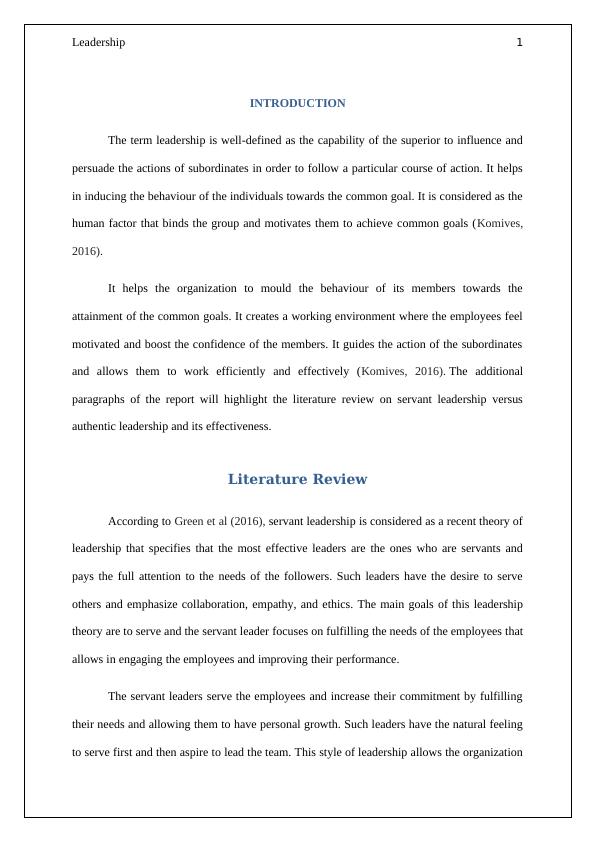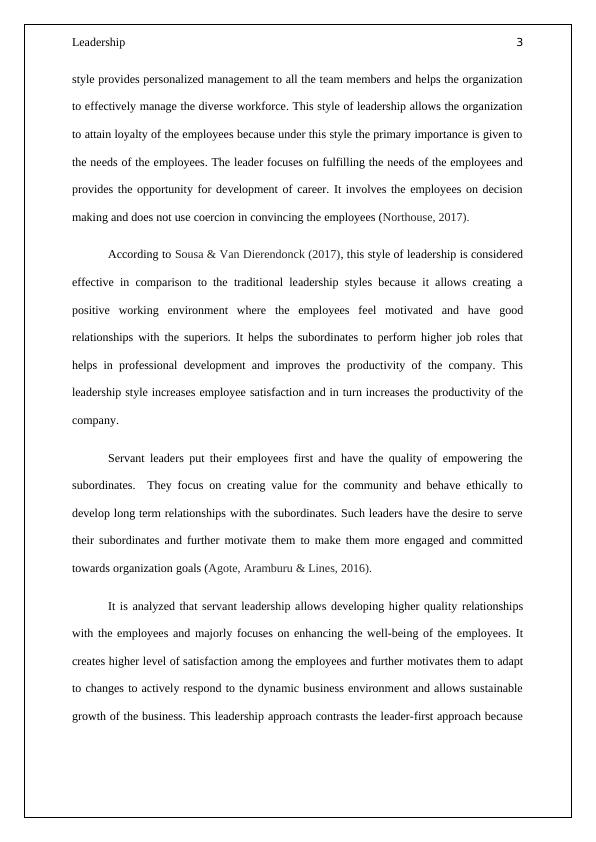Servant leadership versus Authentic leadership
Added on 2022-09-18
11 Pages2654 Words48 Views
Leadership 0
Servant leadership versus Authentic
leadership
Student’s Name
9/4/2019
Servant leadership versus Authentic
leadership
Student’s Name
9/4/2019

Leadership 1
INTRODUCTION
The term leadership is well-defined as the capability of the superior to influence and
persuade the actions of subordinates in order to follow a particular course of action. It helps
in inducing the behaviour of the individuals towards the common goal. It is considered as the
human factor that binds the group and motivates them to achieve common goals (Komives,
2016).
It helps the organization to mould the behaviour of its members towards the
attainment of the common goals. It creates a working environment where the employees feel
motivated and boost the confidence of the members. It guides the action of the subordinates
and allows them to work efficiently and effectively (Komives, 2016). The additional
paragraphs of the report will highlight the literature review on servant leadership versus
authentic leadership and its effectiveness.
Literature Review
According to Green et al (2016), servant leadership is considered as a recent theory of
leadership that specifies that the most effective leaders are the ones who are servants and
pays the full attention to the needs of the followers. Such leaders have the desire to serve
others and emphasize collaboration, empathy, and ethics. The main goals of this leadership
theory are to serve and the servant leader focuses on fulfilling the needs of the employees that
allows in engaging the employees and improving their performance.
The servant leaders serve the employees and increase their commitment by fulfilling
their needs and allowing them to have personal growth. Such leaders have the natural feeling
to serve first and then aspire to lead the team. This style of leadership allows the organization
INTRODUCTION
The term leadership is well-defined as the capability of the superior to influence and
persuade the actions of subordinates in order to follow a particular course of action. It helps
in inducing the behaviour of the individuals towards the common goal. It is considered as the
human factor that binds the group and motivates them to achieve common goals (Komives,
2016).
It helps the organization to mould the behaviour of its members towards the
attainment of the common goals. It creates a working environment where the employees feel
motivated and boost the confidence of the members. It guides the action of the subordinates
and allows them to work efficiently and effectively (Komives, 2016). The additional
paragraphs of the report will highlight the literature review on servant leadership versus
authentic leadership and its effectiveness.
Literature Review
According to Green et al (2016), servant leadership is considered as a recent theory of
leadership that specifies that the most effective leaders are the ones who are servants and
pays the full attention to the needs of the followers. Such leaders have the desire to serve
others and emphasize collaboration, empathy, and ethics. The main goals of this leadership
theory are to serve and the servant leader focuses on fulfilling the needs of the employees that
allows in engaging the employees and improving their performance.
The servant leaders serve the employees and increase their commitment by fulfilling
their needs and allowing them to have personal growth. Such leaders have the natural feeling
to serve first and then aspire to lead the team. This style of leadership allows the organization

Leadership 2
to explore its potential and exploit the growth of the business by establishing long term
relations with the followers and encouraging their commitment by developing long term
relations with the employees (Chiniara & Bentein, 2016).
The servant leaders take responsibility for the needs of the employees and show
dignity and value to the subordinates. Such leader has the characteristics of effective listening
and assumes the intentions of the subordinates. The servant-leader uses persuasion to
convince its followers and does not follow coercion to rule power on the employees.
In accordance with Kiersch & Peters (2017), it is analyzed that there have been shifts
from autocratic leadership models to serving leadership theory. This leadership style focuses
on building a culture of trust and allows the employees to shine. It celebrates individuality,
well-being, and wholeness of the subordinates by realizing their value and allowing to them
balance their work life. They provide flexibility and satisfy the need of the subordinates.
This, in turn, allows the leader to develop a higher vision for the organization.
Considering the above views, it is analyzed that the implementation of servant
leadership has become imperative in the modern workplace. It fosters teamwork and
collaboration among the members. Under this leadership style the leader provides
accountability to its team members and provides the necessary resources that help in creating
comfortable working environment and increasing the job satisfaction of the members. The
servant-leader provides supports to the subordinates and develops pathways that allow the
subordinates to achieve the goals and enhance their personal and professional growth
(Northouse, 2017).
The servant-leader engages itself in honest self-evaluation and collaborates the team
members by valuing them and appreciating their efforts. This helps in motivating the
employees and making them more committed to the goals of the company. This leadership
to explore its potential and exploit the growth of the business by establishing long term
relations with the followers and encouraging their commitment by developing long term
relations with the employees (Chiniara & Bentein, 2016).
The servant leaders take responsibility for the needs of the employees and show
dignity and value to the subordinates. Such leader has the characteristics of effective listening
and assumes the intentions of the subordinates. The servant-leader uses persuasion to
convince its followers and does not follow coercion to rule power on the employees.
In accordance with Kiersch & Peters (2017), it is analyzed that there have been shifts
from autocratic leadership models to serving leadership theory. This leadership style focuses
on building a culture of trust and allows the employees to shine. It celebrates individuality,
well-being, and wholeness of the subordinates by realizing their value and allowing to them
balance their work life. They provide flexibility and satisfy the need of the subordinates.
This, in turn, allows the leader to develop a higher vision for the organization.
Considering the above views, it is analyzed that the implementation of servant
leadership has become imperative in the modern workplace. It fosters teamwork and
collaboration among the members. Under this leadership style the leader provides
accountability to its team members and provides the necessary resources that help in creating
comfortable working environment and increasing the job satisfaction of the members. The
servant-leader provides supports to the subordinates and develops pathways that allow the
subordinates to achieve the goals and enhance their personal and professional growth
(Northouse, 2017).
The servant-leader engages itself in honest self-evaluation and collaborates the team
members by valuing them and appreciating their efforts. This helps in motivating the
employees and making them more committed to the goals of the company. This leadership

Leadership 3
style provides personalized management to all the team members and helps the organization
to effectively manage the diverse workforce. This style of leadership allows the organization
to attain loyalty of the employees because under this style the primary importance is given to
the needs of the employees. The leader focuses on fulfilling the needs of the employees and
provides the opportunity for development of career. It involves the employees on decision
making and does not use coercion in convincing the employees (Northouse, 2017).
According to Sousa & Van Dierendonck (2017), this style of leadership is considered
effective in comparison to the traditional leadership styles because it allows creating a
positive working environment where the employees feel motivated and have good
relationships with the superiors. It helps the subordinates to perform higher job roles that
helps in professional development and improves the productivity of the company. This
leadership style increases employee satisfaction and in turn increases the productivity of the
company.
Servant leaders put their employees first and have the quality of empowering the
subordinates. They focus on creating value for the community and behave ethically to
develop long term relationships with the subordinates. Such leaders have the desire to serve
their subordinates and further motivate them to make them more engaged and committed
towards organization goals (Agote, Aramburu & Lines, 2016).
It is analyzed that servant leadership allows developing higher quality relationships
with the employees and majorly focuses on enhancing the well-being of the employees. It
creates higher level of satisfaction among the employees and further motivates them to adapt
to changes to actively respond to the dynamic business environment and allows sustainable
growth of the business. This leadership approach contrasts the leader-first approach because
style provides personalized management to all the team members and helps the organization
to effectively manage the diverse workforce. This style of leadership allows the organization
to attain loyalty of the employees because under this style the primary importance is given to
the needs of the employees. The leader focuses on fulfilling the needs of the employees and
provides the opportunity for development of career. It involves the employees on decision
making and does not use coercion in convincing the employees (Northouse, 2017).
According to Sousa & Van Dierendonck (2017), this style of leadership is considered
effective in comparison to the traditional leadership styles because it allows creating a
positive working environment where the employees feel motivated and have good
relationships with the superiors. It helps the subordinates to perform higher job roles that
helps in professional development and improves the productivity of the company. This
leadership style increases employee satisfaction and in turn increases the productivity of the
company.
Servant leaders put their employees first and have the quality of empowering the
subordinates. They focus on creating value for the community and behave ethically to
develop long term relationships with the subordinates. Such leaders have the desire to serve
their subordinates and further motivate them to make them more engaged and committed
towards organization goals (Agote, Aramburu & Lines, 2016).
It is analyzed that servant leadership allows developing higher quality relationships
with the employees and majorly focuses on enhancing the well-being of the employees. It
creates higher level of satisfaction among the employees and further motivates them to adapt
to changes to actively respond to the dynamic business environment and allows sustainable
growth of the business. This leadership approach contrasts the leader-first approach because

End of preview
Want to access all the pages? Upload your documents or become a member.
Related Documents
Servant Leadership versus Authentic Leadership-critique the two and their effectivenesslg...
|9
|3031
|125
Assignment on Leadership in the Global Contextlg...
|10
|2169
|30
Servant Leadership and its Impacts Assignmentlg...
|4
|628
|36
Comparison of Servant Leadership and Authentic Leadership Styleslg...
|9
|2679
|358
Leadership and Theorylg...
|9
|2701
|35
Leadership Theory and Practice: Literature Review on Servant Leadershiplg...
|15
|4800
|421